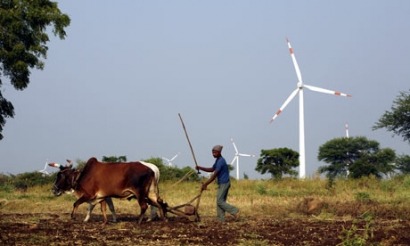
According to the ‘Indian Wind Energy Outlook 2011’ published today by the World Institute of Sustainable Energy (WISE), the Indian Wind Turbine Manufacturers Association (IWTMA) and the Global Wind Energy Council (GWEC), 65.2 GW of wind power could be installed in Indian by 2020, up from 13.1 GW at the end of 2010. By 2030, the installed capacity could reach as much as 160.7 GW.
The Gulf of Mexico oil spill, political upheaval threatening oil and gas supplies from the Middle East and most recently the Fukushima nuclear disaster in Japan, have intensified the debate about the world’s energy supply, and are precipitating a paradigm shift in the thinking of many national governments and international organisations.
“A return to old-fashioned power generation cannot be the answer, not only for environmental, but also for economic reasons. Betting on the obsolete polluting technologies of the past is not a viable solution, and only renewable energy can fill the gap that will be left by nuclear power in a sustainable fashion,” said Steve Sawyer, GWEC’s Secretary General.
Scaling up wind power would not only have environmental but also economic benefits, and wind is already now competitive with conventional new-built power generation technologies such as natural gas. In India, reaching 65.2 GW of wind by 2020 would attract around $10.4bn of annual investment to the sector, and create 170,000 ‘green collar’ jobs in manufacturing, project development, installation, operation, maintenance, consulting etc. At the same time, it would save 174 tons of carbon dioxide every year.
“The Indian government has been committed to exploiting the country’s vast renewable energy resources for the last three decades, and the time has now come to elevate this political will to concrete action, both to reap the domestic benefits from renewable energy development, and to build on India’s growing leadership internationally in resolving both the energy and climate challenges,” said DV Giri, Chairman of IWTMA.
The report argues that India’s potential for wind power development is higher than previously thought, reaching up to 100 GW, and much more if the potential of offshore wind power development and repowering are fully exploited.
“We look forward to working closely with all stakeholders to strengthen India’s role in driving global wind power development, and also support the efforts towards developing a comprehensive renewable energy law which would reinforce India’s National Action Plan on Climate Change target of 15% renewable energy by 2020,” added GM Pillai, WISE’s Director General.
In order to make the most of the indigenous energy source at its doorstep, the Indian government needs to address several challenges and barriers that are holding back development. This includes a clear renewable energy framework at national level, incentives for repowering, and rapid upscaling of grid infrastructure to transport increasing amounts of wind power to the demand centres.
For additional information:

